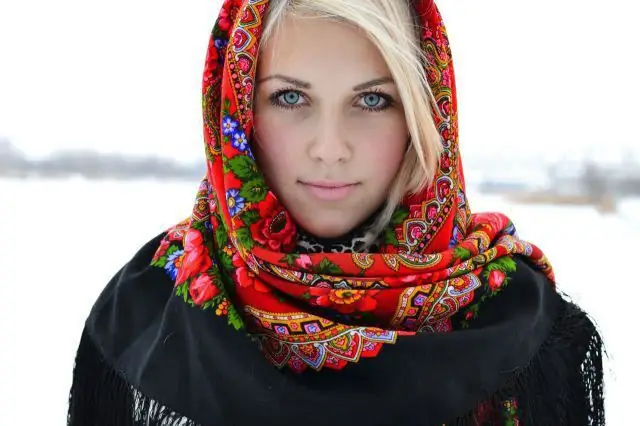- Author Henry Conors [email protected].
- Public 2024-02-12 02:54.
- Last modified 2025-01-23 09:07.
Armenians are an ancient people, who have experienced many trials. Being in the center of the region, where armed conflicts have been smoldering and flaring up for several millennia, they were able to preserve their originality. Even the Armenian female names, to which this article is dedicated, bear the imprint of the history of this people.

Anahit
It is believed that the most beautiful Armenian female names are those used in the pre-Christian era. For example, one of the oldest is Anahit. This name was given to girls in honor of the Zoroastrian supreme goddess, who was considered the mother of knowledge, a healer and was depicted with a baby in her arms. When the country began to be Hellenized in the first century AD, Anahit was identified with the Greek goddess Artemis.
Astghik
Telling about the beautiful Armenian female names of the pagan period, one cannot fail to mention Astghik, which means "star" in translation. This name is also associated with the pagan pantheon. That was the name of the ancient Armenian goddess, who inthe Hellenistic era began to be identified with Aphrodite and with the planet Venus.
In honor of Astghik, a rose festival was held every year. It has survived to this day and is known as Vardavar (from the word "vard", i.e. rose). On this day, both old and young pour water on each other, calling for prosperity and prosperity for their families. In ancient times, in this way, the peasants begged the gods for rain, on which the harvest depended. In addition, they showered young girls with rose petals in memory of the love of the thunder god Vagan for Astghik.

Hripsime, Gayane and Shoghakat
Most of the Armenian female names that newborn babies are called today are associated with Christian saints, including those revered by the Orthodox Church.
For people who are far from history, let's say that the Armenians were the first in the world to adopt Christianity as the state religion. It happened in 301 AD, in the era when Emperor Diocletian ruled in Rome, who organized the most severe persecution of Christians.
Today, on the streets of Yerevan, you can meet many girls and women who bear Armenian female names Hripsime, Gayane, Shoghakat (Shoghik). They were named so in honor of the holy martyrs, whose memory the Orthodox Church celebrates on September 30.
The beautiful Hripsime, together with Shoghakat and other Christian women who decided to become the brides of the Lord, fled to Armenia from Diocletian. King Trdat fell in love with a girl and called her to his palace along with her mentor Gayane. Hripsime did not give up and was martyred along with her friends. This iswas the reason for the imposition of a curse on Tsar Trdat by Gregory the Illuminator. In order to be cured of a terrible disease, the latter repented, was baptized himself and commanded the entire Armenian people to do this.
Christian Armenian female names
According to the tradition adopted by Catholics, Orthodox, Protestants and representatives of the ancient Eastern churches, which include Armenians, children are named after biblical and New Testament characters.
Armenian female names Mariam (Mary), Anna, Yehisabet (Elizabeth), Vergine (Eugenia), Noem, Susanna, etc. have this origin. Unfortunately, many of them are gradually being replaced by more “fashionable” ones.

Meaningful names
Like other peoples, Armenians often named their daughters after the names of flowers. So the names appeared:
- Ward (rose);
- Manushak (violet);
- Asmik (jasmine);
- Shushan (lily);
- Nargiz (daffodil) and others
Some Armenian female names, the list of which is presented below, repeat the names of precious stones and metals. This is:
- Margaret (pearl);
- Almast (diamond);
- Satenik (amber);
- Goar (gem, diamond);
- Piruz (turquoise);
- Waxes (gold), etc.

“Strange” names
The meaning of some Armenian female names may shock foreigners. For example, Nubar means “first harvest” or “first fruit of a fruit tree”. This name could be givenonly the firstborn, both male and female.
Armenians have an excellent sense of humor. Suffice it to recall the stars of KVN or the jokes of the Armenian radio. Even when coming up with names for their daughters, some dads couldn't help but joke. This is how the name Bawakan came about. In translation, it means “enough”, and they were called the 5th-7th daughter in a row in families where fathers had already despaired of waiting for the birth of their son.
Feature-names
In ancient times, Armenians believed that the way they name their children would influence their fate and how they would grow up. So the names Sirun (beauty), Amest (modest), Anush (sweet, sweet), Erjanik (happy) appeared. It is not known whether this is so or not. However, there are many works of oral folk art that tell about the girl Sirun, terrible as a mortal sin, or about the brawler Amest.
Derived from male names
Even in pre-Christian times, Armenians called their babies female, adding to their name the root “dukht”, which was a modified version of the Persian word “dukhtar”. Probably, many will remember the poem by Sergei Yesenin, in which the poet refers to Shagana. In fact, the girl's name was Shaandukht Hambardzumyan.
Later, women's names began to be obtained by adding the suffix “ui” to the men's. This is how the names Tigranui, Armenui, Grachui, Nairui and others came about.

“Overseas influences”
Armenians are a people who preserve their traditions and at the same time are ready for “experiments”. When after the revolutionthe church began to be persecuted, the new authorities managed to eradicate the custom of giving children only traditional and Christian names. First, Roses appeared in Armenia, named after Rosa Luxembourg, then Ninel (the reverse reading of the name Lenin), etc. However, the communist ideology soon succumbed under the onslaught of literary heroes. With the increase in the number of people who visited theaters and became interested in reading, the number of Ophelia, Desdemona, Sylv and Juliet also increased. Soon these names became fashionable among the villagers. True, they were quickly changed and began to be called daughters Julo, Deso or Ofel. In the new millennium, Milena, Katrina and Elena were on the “crest of the wave”. What names will be used in the future is unknown. However, at the moment there is a tendency to return to pagan names. For example, parents are increasingly calling their daughters Mane, Nana, Nare and others.
Now you know the most popular Armenian female names and their meanings. As you can see, their study can help in understanding the nature of the people, and they themselves are intangible evidence of its history.






